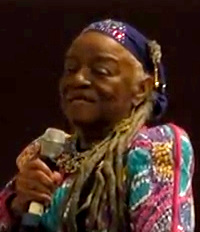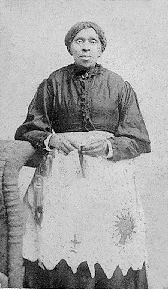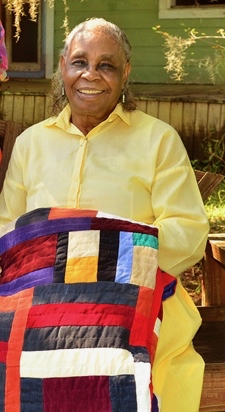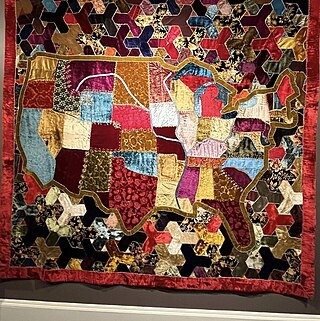
Quilting is the term given to the process of joining a minimum of three layers of fabric together either through stitching manually using a needle and thread, or mechanically with a sewing machine or specialised longarm quilting system. An array of stitches is passed through all layers of the fabric to create a three-dimensional padded surface. The three layers are typically referred to as the top fabric or quilt top, batting or insulating material, and the backing.

Patchwork or "pieced work" is a form of needlework that involves sewing together pieces of fabric into a larger design. The larger design is usually based on repeating patterns built up with different fabric shapes. These shapes are carefully measured and cut, basic geometric shapes making them easy to piece together.

A quilt is a multi-layered textile, traditionally composed of two or more layers of fabric or fiber. Commonly three layers are used with a filler material. These layers traditionally include a woven cloth top, a layer of batting or wadding, and a woven back combined using the techniques of quilting. This is the process of sewing on the face of the fabric, and not just the edges, to combine the three layers together to reinforce the material. Stitching patterns can be a decorative element. A single piece of fabric can be used for the top of a quilt, but in many cases the top is created from smaller fabric pieces joined, or patchwork. The pattern and color of these pieces creates the design.

African-American art is a broad term describing visual art created by African Americans. The range of art they have created, and are continuing to create, over more than two centuries is as varied as the artists themselves. Some have drawn on cultural traditions in Africa, and other parts of the world, for inspiration. Others have found inspiration in traditional African-American plastic art forms, including basket weaving, pottery, quilting, woodcarving and painting, all of which are sometimes classified as "handicrafts" or "folk art".

Faith Ringgold is an American painter, painting on different materials including fabric, a published author, mixed media sculptor, performance artist, and intersectional activist, perhaps best known for her narrative quilts.
Marie Daugherty Webster was a quilt designer, quilt producer, and businesswoman, as well as a lecturer and author of Quilts, Their Story, and How to Make Them (1915), the first American book about the history of quilting, reprinted many times since. She also ran the Practical Patchwork Company, a quilt pattern-making business from her home in Wabash, Indiana, for more than thirty years. Webster's appliquéd quilts influenced modern quilting designs of the early twentieth century. Her quilts have been featured in museums and gallery exhibition in the United States and Japan. The Indianapolis Museum of Art holds the largest collection of her quilts in the United States. Webster was inducted into the Quilters Hall of Fame in 1991. The Marie Webster House, her former residence in Marion, Indiana, was listed on the National Register of Historic Places in 1992, was designated a National Historic Landmark in 1993, and serves as the present-day home of the Quilters Hall of Fame.
Quilts of the Underground Railroad describes a controversial belief that quilts were used to communicate information to African slaves about how to escape to freedom via the Underground Railroad. It has been disputed by a number of historians.

Harriet Powers was an American folk artist and quilter. Born into slavery in rural northeast Georgia, she married young and had a large family. After the American Civil War and emancipation, she and her husband became landowners by the 1880s, but lost their land due to financial problems.
Quilt art, sometimes known as art quilting, mixed media art quilts or fiber art quilts, is an art form that uses both modern and traditional quilting techniques to create art objects. Practitioners of quilt art create it based on their experiences, imagery, and ideas, rather than traditional patterns. Quilt art generally has more in common with the fine arts than it does with traditional quilting. Quilt art is typically hung or mounted.
Cuesta Benberry was an American historian and scholar. Considered to be one of the pioneers of research on quiltmaking in America, she was the pioneer of research on African-American quiltmaking. Her involvement in quilt research spans from founding and participating in various quilt groups to writing articles in renowned quilt magazines and journals. As a quilt scholar, Benberry acquired a collection of important quilts dating from the late 19th century up to the 21st century, as well as an extensive collection of paper documents supplementing quilting exhibitions, books, articles and her personal research.
Katherine Westphal was an American textile designer and fiber artist who helped to establish quilting as a fine art form.
Michael Cummings is an American artist and quilter who lives in Harlem, New York.
Women of Color Quilters Network (WCQN) is a national organization dedicated to preserving African American quiltmaking.
Wini "Akissi" McQueen is an American quilter based in Macon, Georgia. Her artistic production consists of hand-dyed accessories and narrative quilts. Her techniques for her well-known quilts include an image transferring process. In her work, she tackles issues of race, class, society, and women. Her quilts have featured in many museum exhibitions, including the Museum of African American Folk Art, the Taft Museum, the Bernice Steinbam Gallery, and the William College Art Museum. In 2020, her quilts were featured in a retrospective dedicated to her textile art at the Museum of Arts & Sciences in Macon, GA.
Martha Neill Upton was a watercolorist, sculptor and studio quilt artist. Her quilted tapestries helped quilts become seen as fine art, rather than craft work, during the early 1970s. Her quilts were shown in the first major museum exhibition of non-traditional quilts, The New American Quilt at New York's Museum of Arts and Design, then called the Museum of Contemporary Craft, in 1976.

Mary Lee Bendolph is an American quilt maker of the Gee's Bend Collective from Gee's Bend (Boykin), Alabama. Her work has been influential on subsequent quilters and artists and her quilts have been exhibited in museums and galleries around the country. Bendolph uses fabric from used clothing for quilting in appreciation of the "love and spirit" with old cloth. Bendolph has spent her life in Gee's Bend and has had work featured in the Philadelphia Museum of Art as well as the Minneapolis Institute of Art in Minnesota.
Gwendolyn (Gwen) Ann Magee was an African-American fiber artist. Learning to quilt in the middle of her life, Magee quickly became known in the world of fiber art for her abstract and narrative quilts depicting the African-American experience. Her work can be found in the permanent collections of the Mississippi Museum of Art, the Museum of Mississippi History, the Michigan State University Museum, and the Renwick Gallery of the Smithsonian Museum of American Art, and has been exhibited internationally.
Bisa Butler is an American fiber artist who has created a new genre of quilting that has transformed the medium. Although quilting has long been considered a craft, her interdisciplinary methods -- which create quilts that look like paintings -- have catapulted quilting into the field of fine art. She is known for her vibrant, quilted portraits celebrating Black life, portraying both everyday people and notable historical figures. Her works now count among the permanent collections at the Smithsonian National Museum of African American History and Culture, the Art Institute of Chicago, Pérez Art Museum Miami and about a dozen other art museums nationwide. She has also exhibited at the Smithsonian Museum of American History, the Epcot Center, the National Underground Railroad Freedom Center, and many other venues. In 2020, she was commissioned to quilt cover images for Time magazine, including the "Person of the Year" issue and its "100 Women of the Year" issue. With a multi-year wait list for private commissions, one of Butler's quilts sold at auction in 2021 for $75,000 USD.

Sandy Fife Wilson is a Muscogee (Creek) art educator, fashion designer and artist. After graduating from the Institute of American Indian Arts and Northeastern Oklahoma State University, she became an art teacher, first working in the public schools of Dewey, Oklahoma. When Josephine Wapp retired as the textile instructor at the Institute of American Indian Arts, Wilson was hired to teach the design courses. After three years, in 1979, she returned to Oklahoma and taught at Chilocco Indian School until it closed and then worked in the Morris Public School system until her retirement in 2009.

Narrative quilting describes the use of blanket weaving and quilting to portray a message or tell a story. It was a means of sending messages and recording history for women that were unable to participate in politics throughout time.








